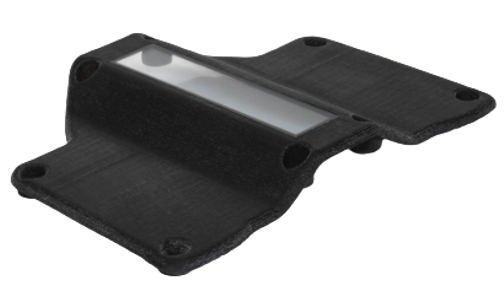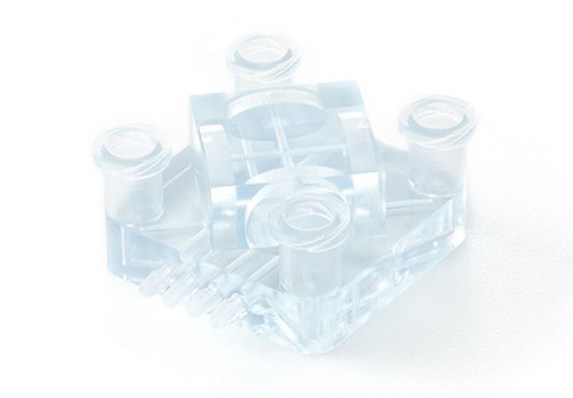
PolyJet 3D Printing Service
Get 3D-printed elastomeric parts within days. Request an online quote today.
Certifications ISO 9001:2015 | ITAR
Jump to Section
→ Capabilities
→ Materials
→ PolyJet 3D Printers
→ About PolyJet 3D Printing
PolyJet is an industrial 3D printing process that builds multi-material prototypes with flexible features and complex parts with intricate geometries in as fast as 1 day. A range of hardnesses (durometers) are available, which work well for components with elastomeric features like gaskets, seals, and housings.
Common applications for PolyJet 3D printing:
- prototyping designs for overmolding or silicone rubber parts
- combining two colors or durometers into a single part
- simulating elastomers or flexible parts

PolyJet Design Guidelines and Capabilities
Our basic guidelines for PolyJet include important design considerations to help improve part manufacturability, enhance cosmetic appearance, and reduce overall production time.
| US | Metric | |
| Maximum Part Size | 19.3 in. x 15.4 in. x 7.9 in. | 490mm x 390mm x 200mm |
| Layer Thickness | 0.00118 in. | 30 microns |
| Minimum Feature Size | 0.012 in. | 0.3mm |
| Minimum Freestanding Wall, Hole, or Channel Size | 0.030 in. | 0.76mm |
Tolerances for PolyJet: For well-designed parts, tolerances of ±0.005 (0.1mm) for the first inch plus 0.1% of nominal length can typically be achieved. Note that tolerances may change depending on part geometry.

PolyJet Material Options
PolyJet provides the ability to choose a desired hardness or combine material properties into a single build, which makes it ideal for prototyping overmolding parts. Shore A hardnesses of 30A, 40A, 50A, 60A, 70A, 85A, 95A, and rigid are available in these colors:
- Digital Clear/Translucent
- Digital Black
- Digital White
Compare PolyJet Material Properties
| Material | Tensile Tear Strength | Tensile Strength | Elongation |
|---|---|---|---|
| 30A | 85 psi | 399 psi | 245% |
| 40A | 100 psi | 508 psi | 200% |
| 50A | 114 psi | 508 psi | 190% |
| 60A | 121 psi | 580 psi | 160% |
| 70A | 185 psi | 725 psi | 130% |
| 85A | 341 psi | 1,088 psi | 80% |
| 95A | 398 psi | 1,740 psi | 60% |
| Rigid | n/a | 8,702 psi | 17.5% |
| Material | Tensile Tear Strength | Tensile Strength | Elongation |
|---|---|---|---|
| 30A | 0.59 MPa | 2.75 MPa | 245% |
| 40A | 0.69 MPa | 3.5 MPa | 200% |
| 50A | 0.79 MPa | 3.5 MPa | 190% |
| 60A | 0.83 Mpa | 4.0 Mpa | 160% |
| 70A | 1.28 Mpa | 5.0 Mpa | 130% |
| 85A | 2.35 Mpa | 7.5 Mpa | 80% |
| 95A | 2.74 Mpa | 12.0 Mpa | 60% |
| Rigid | n/a | 60.0 Mpa | 17.5% |
These figures are approximate and dependent on a number of factors, including but not limited to, machine and process parameters. The information provided is therefore not binding and not deemed to be certified. When performance is critical, also consider independent lab testing of additive materials or final parts.
How Does PolyJet 3D Printing Work?
The PolyJet process begins by spraying small droplets of liquid photopolymers in layers that are instantly UV cured. Voxels (three-dimensional pixels) are strategically placed during the build, which allow for the combination of both flexible and rigid photopolymers know as digital materials. Each voxel has a vertical thickness equal to the layer thickness of 30 microns. The fine layers of digital materials accumulate on the build platform to create accurate 3D-printed parts.
Each PolyJet part is completely coated in support material during the build, which ultimately is removed by hand using a pressurized water stream and a chemical solution bath. No post-curing is required after the manufacturing process.










